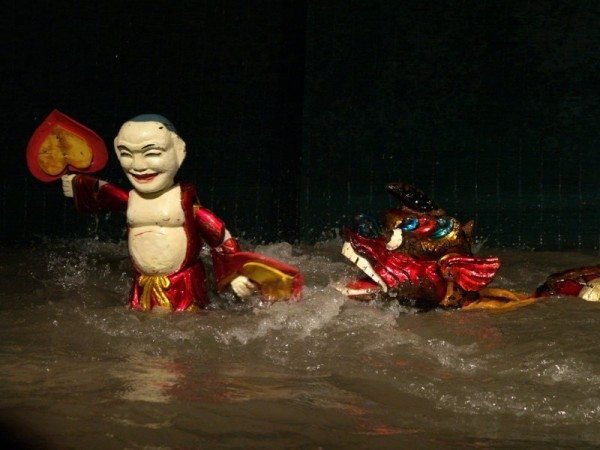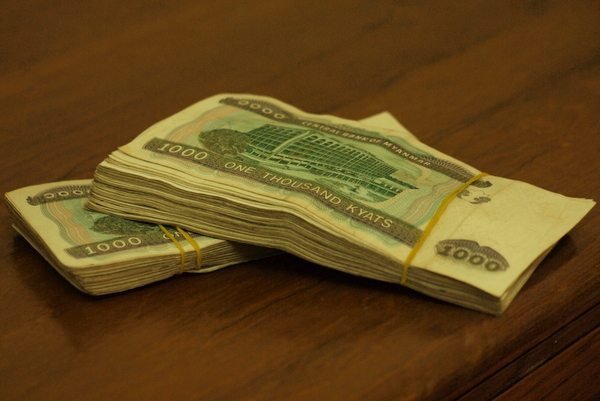Vietnamese Puppetry: Just Add Water
A colorful, wooden fisherman, almost as big as his traditional Vietnamese fishing boat, sits in the bow with a fishing rod and a line dangling into the water. Suddenly, a fish as big has he is leaps from the murky depths and disappears again in a splash. The fisherman and his boat give chase and the fish turns the fictional sea into a turbulent storm, sending the audience into a fit of giggles. In the next scene a dragon undulates into view, sparks shooting from its mouth as the cymbals of the orchestra crash and the drums beat faster and faster with excitement. Eight angels move gracefully across misty waters in a synchronized dance. (See the full Vietnamese water puppet photo gallery)
All of these characters rise out of the water, their means of movement hidden from view. Known as Múa rối nước or “puppets that dance on water,” this traditional puppetry style is a cultural treasure that can only be found in Vietnam.
The practice originated in the 11th century in northern Vietnam among the people of the Red River Delta. When the busy harvest season was past, puppeteers had time to carve their wooden puppets, and then they would employ them in community festivals, especially when spring rolled around once again. Besides the entertainment aspect of the puppet shows they were also thought to keep the mischievous spirits of Vietnamese animistic beliefs from making trouble. But what really made the art unique was the setting itself.
The stage was the surface of the community’s central pond. The puppeteers stood – and still stand — in water up to their waists, hidden from view by a bamboo curtain. The tales they tell through their art are those of the farmers. Many of the puppets themselves are common characters from the rice paddies, just regular folk, but the stories can involve myths, legends, and well known heroes and spirits as well. The puppets employ themselves in the same activities as the villagers: they plant rice, keep ducks, and go fishing. They are ordinary characters finding themselves in extraordinary circumstances from love stories to dragon encounters.
Originally these shows were outdoors. While water puppetry can still be seen in some villages, most travelers will attend performances in special theatres, often in Hanoi or Ho Chi Minh City. The “stage” is actually a raised pool with a set behind it in the shape of a pagoda rising up from the water. A bamboo curtain underneath the pagoda hides the puppeteers.
The show is accompanied by a small group of musicians playing traditional instruments and singing narrators telling the audience what is going on and adding commentary. Sometimes they even shout warnings to the puppets as danger approaches.
Each show begins with Chú Tễu (Uncle Teu), a jester character much like the character Punch of Western puppet shows. He interacts with the audience, connecting the worlds of observers and players, and bringing a narrative across the water. He appears as a pudgy figure — often wearing nothing but a loincloth and perhaps an open vest — smiling, and showing rosy cheeks. His job is to keep the mood light, to celebrate the victories of characters in the stories, and to throw in a bit of crude humor. He starts off the night’s show by addressing the audience and returns for each new story to introduce new characters and deliver the exposition of what’s about to unfold.
Besides the villagers and Uncle Teu, puppets include frogs, fish, dragons, turtles, fairies, and even water buffalo. The arms of a swimmer paddle through the water. The dragon spouts sparks. A fisherman exhales smoke from his cigarette.
The puppets, which can weigh as much as 25 pounds or more, are carved from wood and then painted with colorful lacquers to make them waterproof. The figures stand about two feet tall and have several movable parts, often limbs but also facial expressions or tools. The puppets are attached to long bamboo poles that reach straight out from under the curtain but are never seen above the surface of the water. While the puppets often have some buoyancy or a float incorporated into them, a good deal of strength is nevertheless required to keep the puppet upright and move it around so quickly and skillfully while working the strings and pulleys at the same time to make the figure come alive. For the more complicated figures, such as an undulating sea dragon, one or two other puppeteers must assist; on the other hand some puppeteers may be working with two puppets at the same time.
Dry-ice fog drifting out over the water adds a bit more mystique to the experience. Some characters interact, passing objects to and fro or making battle – but the puppeteers surely have a devil of a time pulling this off without really being in a position to see it clearly. There are as many as eight puppeteers tangling for position behind that bamboo curtain and when the puppets move together like synchronized swimmers or dancers, it is hard to imagine what sort of maneuvers are required by the human controllers. In fact, they have a code that they shout to each other to help coordinate the action.
Part of the thrill of watching a Vietnamese water puppet show is similar to that of seeing a magician perform: how do they do it? The puppeteers are tight-lipped about how they perform their art, and when audience members witness characters passing around each other as if there were no attachments beneath the surface of the water, some even wonder if the whole thing is done by some sort of mechanical device.
The skill is passed down from generation to generation, often within a family. The artists keep the methods secret, and as they stand behind a screen and work with their hands plunged into the water, there really isn’t any way for observers to figure out what they are doing. (The water is made murky with mud or coloring to keep the mechanics hidden.)
Even in warm weather standing in the water so long can get very cold, and many modern puppeteers wear water-resistant clothing such as waders to keep from getting too chilled. Rheumatism was common in puppeteers of the past; so were leech bites.
In Hanoi, one of the best places to see a puppetry show is Thang Long Water Puppetry Theatre. The group keeps the tradition alive with daily shows, but also travels to festivals abroad to share the art. In Ho Chi Minh City, the most popular show is at Golden Dragon Water Puppet Theatre. Or if you are lucky, you can find your way to a village that still has its own performers’ guild.
You shouldn’t miss an opportunity to see a water puppet show. And you can even take a bit of the tradition home with you: Full-sized puppets or smaller souvenir versions are sold outside the theaters and in some of the street markets. Water not included.
_____________________________________
See more photos of this Vietnamese water puppet show
Read some of my posts about Vietnam over on The Blog (revtravel.com)













 ORDER YOUR COPY TODAY!
ORDER YOUR COPY TODAY! ORDER YOUR COPY TODAY!
ORDER YOUR COPY TODAY!
Welcome to Hanoi, Krev. Beautiful city. Beware the ice in the iced coffee, however. Did the turtle rise up from Hoan Kiem Lake with the sword????
It did in fact. Turtle soup was on special in the French Quarter for a couple days thereafter.
Pingback: Photo Gallery: Vietnamese Water Puppets in Ho Chi Minh City